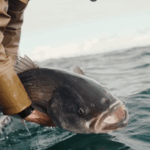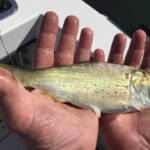
Release Mortality Revisited: New Research from Massachusetts DMF
Feature Photo Credit: Robbie Tartaglia What’s going on? For decades, striped bass management relied on a
We have been focused on menhaden for the past few weeks, and rightfully so, as the vote on Ecological Reference Points (ERPs) will headline the upcoming Atlantic States Marine Fisheries Commission (ASMFC) meeting. However, major striped bass decisions are also on the table. We were so entrenched in the menhaden decision that we almost let the striped bass issue slip by.
Capt. Peter Fallon, President of the Maine Charter Boat Association and a good friend of ASGA, reminded us of striped bass conservation issues on the agenda for the upcoming ASMFC meeting. Thanks, Capt.! We are all in this together and we appreciate working with your organization.
After an initial meeting from 9-10 am on Monday, August 3, the Atlantic Striped Bass Management Board will reconvene on Tuesday, August 4 from 3-4 pm. The agenda items of interest for this second meeting are listed below:
[Quote]
The first postponed motions concern the amendment process (Issue #1) we have been telling you about for almost a year, while the second postponed motion concerns state accountability when it comes to rebuilding striped bass (Issue #2). Let’s dig in.
Issue #1: Initiating a New Striped Bass Amendment Process
The process of developing Amendment 7 to the Atlantic Striped Bass Fishery Management Plan will take at least two years and will tackle some very serious management objectives, such as goals of the fishery, reference points, management triggers, rebuilding, and area-specific management. Here are some examples of what revisiting these objectives could mean.
Goals of the Fishery: Are striped bass managed for abundance with greater angling opportunity or harvest with lower angler expectations?
Empirical/Biological/Spatial Reference Points: Essentially, “reference points” describes the target and threshold amount of spawning-aged female striped bass in the system. If the reference points are raised (i.e., the population would have to be at a higher amount of spawning stock biomass compared to now to be considered healthy), that would mean that the minimum number of striped bass left unharvested would increase. Conversely, if the reference points are lowered, there would be less striped bass left in the water for the stock to be considered healthy. The current reference points are based on a year (striped bass spawning stock biomass in 1995, when the stock was considered rebuilt), not biology. We support the best science, so this can be improved. However, for those with ulterior motives this could be an easy way to lower the amount of striped bass left in the water. Rather than directly fight to lower the reference points, some states that want to allow for increased harvest may very well present biological reference points that lower the bar for what’s considered a healthy population under the guise of best science.
Management Triggers: This term indicates how managers must respond under certain circumstances. The current management triggers for striped bass under Amendment 6 [our clarification in brackets] are:
[QUOTE]
1) If the Management Board determines that the fishing mortality threshold is exceeded in any year, the Board must adjust the striped bass management program to reduce the fishing mortality rate to a level that is at or below the target within one year.
2) If the Management Board determines that the biomass has fallen below the threshold in any given year, the Board must adjust the striped bass management program to rebuild the biomass to the target level within the timeframe established in Section 2.6.2 [10 years].
3) If the Management Board determines that the fishing mortality target is exceeded in two consecutive years and the female spawning stock biomass falls below the target within either of those years, the Management Board must adjust the striped bass management program to reduce the fishing mortality rate to a level that is at or below the target within one year.
4) If the Management Board determines that the female spawning stock biomass falls below the target for two consecutive years and the fishing mortality rate exceeds the target in either of those years, the Management Board must adjust the striped bass management program to rebuild the biomass to a level that is at or above the target within the timeframe established in Section 2.6.2 [10 years].
5) The Management Board shall annually examine trends in all required Juvenile Abundance Index [JAI] surveys. If any JAI shows recruitment failure (i.e., JAI is lower than 75% of all other values in the dataset) for three consecutive years, then the Management Board will review the cause of the recruitment failure (e.g. fishing mortality, environmental conditions, disease etc.) and determine the appropriate management action. The Management Board shall be the final arbiter in all management decisions.
[QUOTE]
Any negative changes to these triggers—even something as subtle as changing “must” to “may”—could impede striped bass recovery as well as limit the ability of ASMFC to react swiftly to declines in the striped bass population.
Rebuilding Timelines: Here’s a dose of reality: Striped bass are supposed to be rebuilt in 10 years when the stock falls below the threshold. The current recovery plan goes out to 13 years. After conservation equivalency was used, it was extended to 15 years. If more “flexibility” is employed through the amendment process, we might as well take up tennis. Be very aware of this throughout the next two years.
Area-Specific Management: States representing producer areas like Chesapeake Bay and Delaware Bay, specifically Maryland and Delaware, are going to push for separate management. They just want to harvest more fish. It has nothing to do with what is best for the stock or other states that depend on good recruitment. Until we have a better sense of the area-specific stock composition of our fishery, we feel strongly that striped bass need to be managed coastwide for the best interest of all sectors.
Issue #2: Improving State Accountability in Striped Bass Management
You may recall that at the ASMFC meeting in February, ASGA President and NY Commissioner Capt. John McMurray brought up the topic of accountability for states using conservation equivalency (CE) with striped bass regulations. It was simple: If a state uses CE and fails to meet the necessary reduction, they should be held accountable. It was shot down by MD, NJ, PRFC, and RI.
Then Maine Department of Marine Resources Commissioner Pat Keliher, who is a stalwart supporter of striped bass conservation, put forth the following motion:
Move to task the Plan Review Team to review state reductions in the Fishery Management Plan Review of the 2020 fishing year. If a state is below their predicted target reduction, the Board may direct a state to modify measures for the following fishing year to achieve the target reduction
Pat’s motion was really tame. In plain speak, it simply says that if a state is not meeting the needed reductions, they would need to modify their regulations to make sure they are in line with the recovery of striped bass.
This motion was also tabled for until the August meeting. The recreational sector receives quite a bit of criticism for not being accountable. This motion would give a layer of accountability to the most important fishery on the East Coast.
Pay attention to this part of the discussion. You really have to question the motives of any commissioner or state that opposes accountability for an overfished stock, much less striped bass.
Be on the lookout for our post-meeting blog discussing the outcomes and implications of the Atlantic Striped Bass Management Board’s decisions.

Feature Photo Credit: Robbie Tartaglia What’s going on? For decades, striped bass management relied on a

Recent developments in the 2025 Atlantic Menhaden Stock Assessment Update, released by the Atlantic States

What’s going on? The “most important fish in the sea” just exposed one of the

Mario CampoFisheries Ecologist, Southeastern Louisiana UniversityScience and Policy Associate, American Saltwater Guides Association This discussion
We rely on our members and donations to keep fighting for a sustainable tomorrow in marine conservation.
GIVE THE GIFT OF FISHERIES CONSERVATION THIS HOLIDAY SEASON. SHOP ASGA GOODS THAT FUND FISHERIES RESEARCH & ADVOCACY CAMPAIGNS
JOIN ASGA IN CALLING FOR CRITICAL MANAGEMENT ACTION AFTER YEARS OF SPAWN FAILURES & POOR MANAGEMENT.
By using this website, you agree to our use of cookies. We use cookies to provide you with a great experience and to help our website run effectively. To learn more, please review our privacy policy.